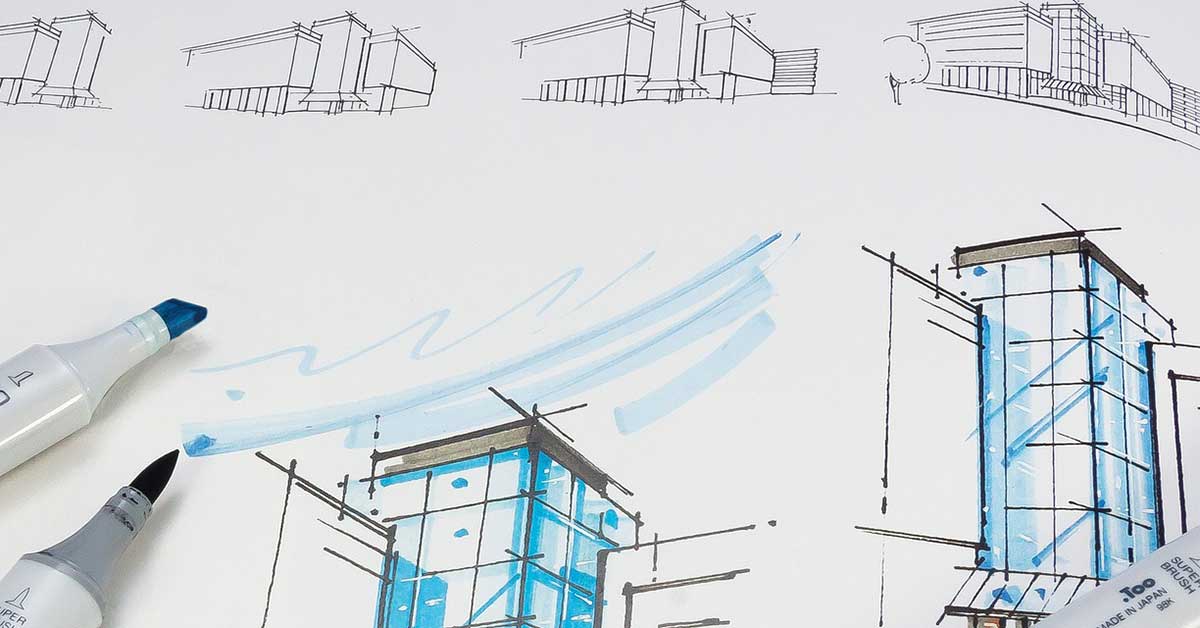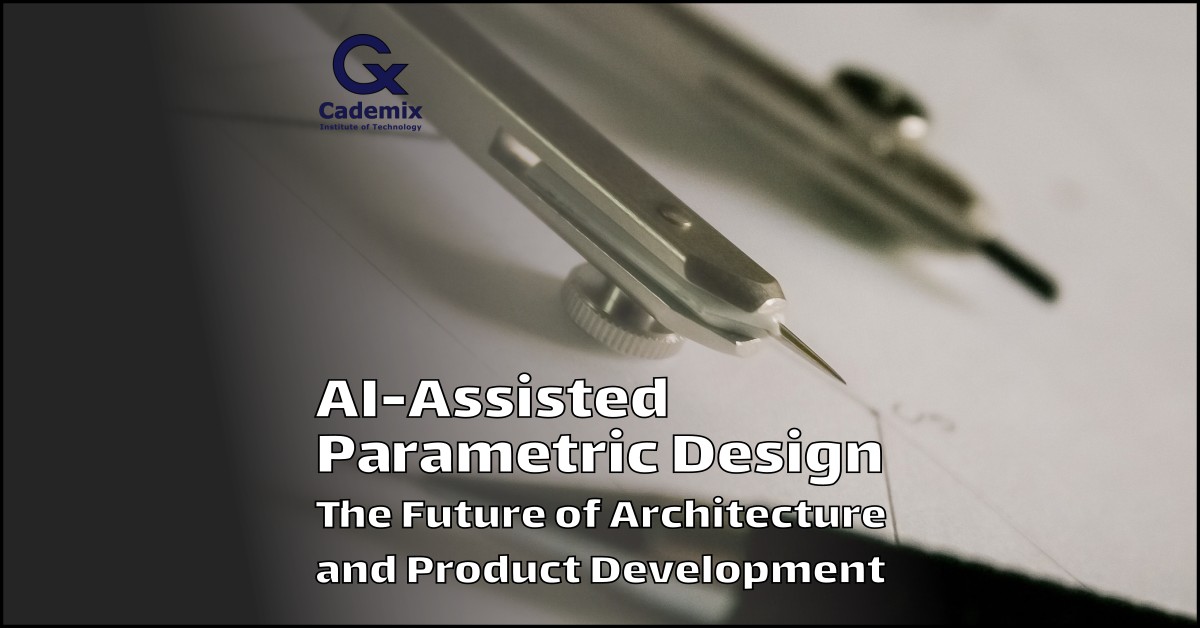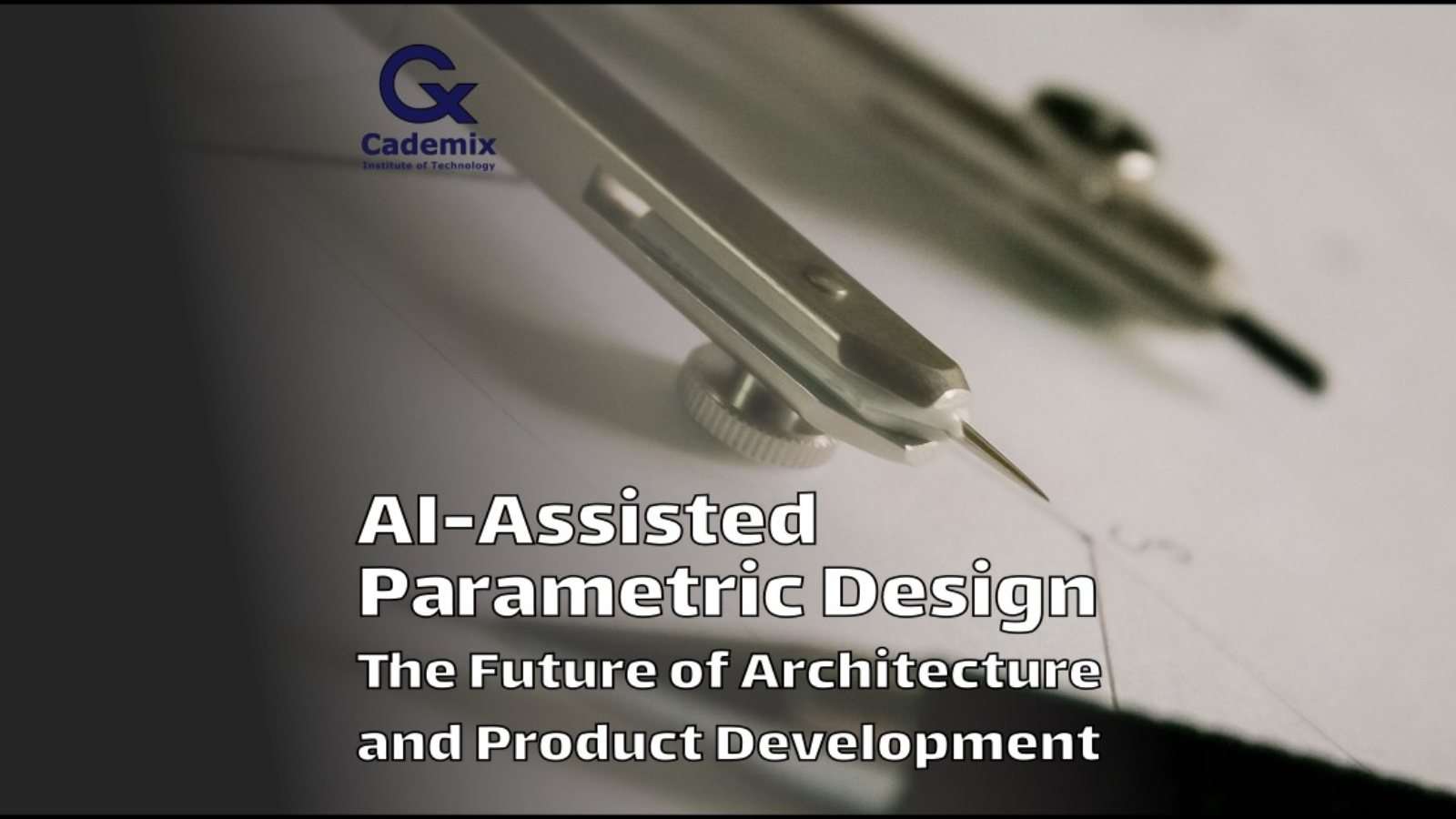I. Introduction
A. What is an AI-assisted parametric design
AI-assisted parametric design is a cutting-edge approach to design that leverages the power of artificial intelligence and machine learning algorithms to create complex, data-driven models. In AI-assisted parametric design, designers use a set of rules, parameters, and constraints to create designs that are optimized for specific goals and objectives. These parameters can range from material properties to spatial requirements, and they allow designers to quickly generate a wide range of potential solutions, while also ensuring that each design meets specific criteria.
One of the main advantages of AI-assisted parametric design is that it allows designers to explore a much larger design space than would be possible through traditional design methods. By using sophisticated algorithms to generate and evaluate large numbers of potential designs, designers can quickly identify the most promising solutions, while also avoiding designs that don’t meet the required criteria. This can help to speed up the design process, while also ensuring that the final design is optimized for performance, efficiency, and other key factors. As such, AI-assisted parametric design has emerged as a powerful tool in fields such as architecture and product development, where complex design problems require sophisticated solutions.
B. Importance of AI-assisted parametric design in Architecture and Product Development
AI-assisted parametric design is increasingly being recognized as a critical tool in the field of architecture. Architects are using AI-assisted parametric design to create more efficient and sustainable buildings that are optimized for specific environmental conditions. For example, AI algorithms can be used to optimize the orientation and shape of a building in order to minimize energy consumption, while also maximizing natural light and ventilation. Additionally, AI-assisted parametric design can be used to create more efficient and cost-effective construction methods, by optimizing the use of materials and reducing waste. By leveraging AI technology, architects can create buildings that are not only more sustainable but also more aesthetically pleasing and functional.
Similarly, in the field of product development, AI-assisted parametric design is transforming the way products are designed and manufactured. By using AI algorithms to optimize the design process, manufacturers can create products that are more efficient, reliable, and cost-effective. For example, AI-assisted parametric design can be used to optimize the shape and composition of a product, in order to minimize production costs and maximize product performance. In addition, AI-assisted parametric design can help manufacturers to better understand and respond to customer needs, by creating products that are tailored to specific user preferences and requirements. As such, AI-assisted parametric design is becoming an essential tool for companies that want to stay competitive in today’s fast-paced, data-driven business environment.
C. State of the Art: AI in creative design process
The use of AI in the creative design process is becoming increasingly popular, with architects and designers leveraging AI-assisted parametric design to explore new design possibilities and optimize design outcomes. AI algorithms can help to automate the design process, allowing architects and designers to quickly generate a range of design options and select the most appropriate one. Moreover, AI can be used to analyze and interpret complex data sets, providing valuable insights that can inform the design process. For example, AI algorithms can be used to analyze environmental data, such as sun angles and wind patterns, in order to optimize building orientation and reduce energy consumption. Overall, AI-assisted parametric design is helping architects and designers to create more innovative and sustainable designs, while also reducing the time and cost involved in the design process.
D. Software and tools for AI-assisted parametric design
There are a variety of software and tools available for AI-assisted parametric design, each with their own strengths and weaknesses. Some of the most popular tools include Autodesk Revit, which is widely used in the field of architecture and offers a range of features for parametric design and BIM modeling. Blender, a powerful open-source 3D modeling software, is also gaining popularity in the architecture and product design industries. Other popular tools include VRay, Lumion, and Rhino, which offer a range of features for rendering, visualization, and analysis. Dynamo, Grasshopper, and Python are powerful programming tools that can be used to develop custom scripts and automate design tasks. Overall, the choice of software and tools for AI-assisted parametric design will depend on the specific needs of the project, as well as the expertise and preferences of the designer or architect.
Here is a list of 20 relevant software and packages that incorporate AI in their software or have the possibility of a parametric design:
- Autodesk Revit: A popular BIM software that has advanced parametric design and analysis tools.
- Blender: An open-source 3D modeling software that is becoming increasingly popular in architecture and product design.
- Rhino: A 3D modeling software that is widely used in industrial and product design for its powerful parametric design tools.
- VRay: A popular rendering and visualization software that is compatible with a wide range of 3D modeling software.
- Lumion: A real-time rendering software that is used to create high-quality visualizations of architectural designs.
- Dynamo: A programming tool for creating custom scripts and automating design tasks in Revit.
- Grasshopper: A powerful algorithmic modeling tool that is widely used in architecture and product design.
- Houdini: A procedural modeling and animation software that has advanced parametric design tools.
- SketchUp: A 3D modeling software that is popular in architecture and product design for its ease of use and quick design iteration.
- 3ds Max: A 3D modeling and animation software that has powerful parametric design and scripting capabilities.
- Fusion 360: A cloud-based CAD/CAM software that is used in product design for its parametric design tools and advanced manufacturing capabilities.
- SolidWorks: A popular 3D modeling software that is used in engineering and product design for its advanced parametric design tools.
- CATIA: A CAD/CAM software that is widely used in aerospace and automotive industries for its advanced parametric design and simulation capabilities.
- ANSYS: A simulation software that is widely used in engineering and product design for its advanced parametric design and analysis capabilities.
- Rhino Inside Revit: A plugin that allows designers to use Rhino’s powerful parametric design tools within Revit.
- ZBrush: A digital sculpting software that has advanced parametric design and modeling tools.
- Substance Designer: A texturing software that has advanced parametric design and procedural generation capabilities.
- Marvelous Designer: A 3D clothing design software that has advanced parametric design and simulation tools.
- BlenderBIM: A plugin for Blender that adds advanced BIM and parametric design tools to the software.
- Substance Alchemist: A material authoring software that uses AI to generate and edit materials with parametric design capabilities.
Again, these software and packages are just a few examples of the wide range of tools available for AI-assisted parametric design, and the choice of software will depend on the specific needs of the project and the expertise of the designer or architect. Please make sure to contact your Cademix Consultant or Mentor to choose the suitable software choices for your application or career development.

II. Applications of AI-Assisted Parametric Design
A. Architecture
Architecture is an area where AI-assisted parametric design has made a significant impact. With the help of AI, architects can create more complex designs in less time, while also considering a wide range of design constraints and environmental factors. Here are some of the applications of AI-assisted parametric design in architecture:
- Building Design: AI-assisted parametric design can be used to generate complex 3D models of buildings quickly and efficiently. With the use of AI, architects can explore a wide range of design options and generate optimized designs that are tailored to specific site and environmental conditions. AI can also be used to optimize the shape and structure of buildings to improve their energy efficiency and reduce their environmental impact.
- Urban Planning: Urban planning is another area where AI-assisted parametric design has the potential to revolutionize the design process. With the help of AI, urban planners can generate optimized designs for cities and neighborhoods that are tailored to specific social, economic, and environmental factors. AI can also be used to analyze and optimize traffic flow, pedestrian movement, and public transportation networks to create more efficient and sustainable urban environments.
- Interior Design: AI-assisted parametric design can also be used to generate complex and visually stunning interior designs. With the use of AI, designers can generate furniture designs that are optimized for specific spaces, materials, and functions. AI can also be used to create personalized designs that are tailored to the specific needs and preferences of individual clients. AI can also help designers to explore a wide range of design options quickly and efficiently, making it easier to find the perfect design for each project.
B. Product development
AI-assisted parametric design has also found numerous applications in the field of product development, from industrial design to automotive design to consumer goods. Here are some of the applications of AI-assisted parametric design in product development:
- Industrial Design: Industrial design involves the creation of new products that are both functional and aesthetically pleasing. With the help of AI, industrial designers can generate optimized designs that are tailored to specific user needs and design constraints. AI can also be used to analyze user feedback and generate designs that are optimized for user satisfaction.
- Automotive Design: Automotive design is another area where AI-assisted parametric design has made a significant impact. With the use of AI, automotive designers can create more efficient and aerodynamic vehicle designs that are optimized for specific performance and safety factors. AI can also be used to optimize the shape and structure of vehicles to reduce their weight and improve their fuel efficiency.
- Consumer Goods: Consumer goods encompass a wide range of products, from electronics to home appliances to furniture. With the help of AI, product designers can generate optimized designs that are tailored to specific user needs and preferences. AI can also be used to analyze user feedback and generate designs that are optimized for user satisfaction. For example, AI can help designers create personalized products that are tailored to the specific needs and preferences of individual users.
C. Marketing
AI-assisted parametric design has not only revolutionized the design process but also has had a significant impact on the way businesses market their products. Here are some of the applications of AI-assisted parametric design in marketing:
- Personalization: Personalization is a powerful marketing tool that can help businesses create more engaging and effective marketing campaigns. With the help of AI, businesses can generate personalized product designs that are tailored to the specific needs and preferences of individual customers. AI can also be used to analyze customer data and generate personalized marketing messages that are more likely to resonate with individual customers.
- Data-Driven Design: Data-driven design is an approach to design that is based on the analysis of large amounts of data. With the help of AI, businesses can collect and analyze customer data to generate designs that are optimized for specific customer needs and preferences. AI can also be used to analyze market trends and generate designs that are more likely to appeal to a wider audience.
- Digital Marketing: Digital marketing is another area where AI-assisted parametric design has made a significant impact. With the help of AI, businesses can generate digital marketing campaigns that are tailored to specific customer needs and preferences. AI can also be used to analyze customer data and generate targeted marketing messages that are more likely to resonate with individual customers. Additionally, AI can help businesses optimize their digital marketing campaigns by analyzing customer behavior and providing insights into how to improve engagement and conversion rates.

III. Approaches to AI-Assisted Parametric Design
When it comes to AI-assisted parametric design, there are several approaches that designers can take. Here are some of the most common approaches to AI-assisted parametric design:
A. Smart User
The smart user approach to AI-assisted parametric design involves using AI to augment the skills and knowledge of human designers. With the help of AI, designers can generate more optimized and efficient designs that are tailored to specific user needs and design constraints. AI can also be used to analyze user feedback and generate designs that are optimized for user satisfaction. In this approach, the designer is still the primary decision-maker, but AI is used to support and enhance their abilities.
B. Human-Centered Design
Human-centered design is an approach to design that focuses on the needs and preferences of the end-user. With the help of AI, designers can generate designs that are optimized for specific user needs and preferences. AI can also be used to analyze user feedback and generate designs that are more likely to be well-received by end-users. In this approach, the end-user is the primary focus, and AI is used to support the designer’s efforts to create designs that are optimized for the end-user’s needs.
C. Algorithmic Architecture
Algorithmic architecture is an approach to architecture that uses computational methods to generate optimized designs. With the help of AI, architects can generate designs that are optimized for specific performance and safety factors. AI can also be used to optimize the shape and structure of buildings to reduce their weight and improve their energy efficiency. In this approach, the designer relies heavily on AI to generate optimized designs that are tailored to specific design constraints and performance requirements.

IV. The Role of Programming Languages in AI-Assisted Parametric Design
A. The importance of learning programming languages
Programming languages are the backbone of any software or tool used in AI-assisted parametric design. While some design software may offer pre-programmed functionalities, the ability to write code and create custom scripts is a crucial skill for designers to possess. This is because custom scripts can help automate repetitive tasks and generate complex design configurations that are not possible through manual means. Additionally, programming languages provide a way to communicate with AI algorithms and integrate them into the design process. For designers who want to specialize in AI-assisted parametric design, learning programming languages is not just important, it is essential.
Programming languages also offer designers a level of flexibility and customization in their work. Instead of relying on pre-existing tools, designers can create their own tools and workflows that are tailored to their specific design needs. This can help designers stand out in a competitive job market and provide a unique perspective on design solutions.
B. The most useful programming and scripting languages for AI-assisted parametric design
Here are some of the most useful programming and scripting languages for AI-assisted parametric design:
- Python: Python is a popular programming language for AI and machine learning, and it is also widely used in parametric design workflows.
- Java: Java is a versatile programming language that is used in a variety of industries, including architecture and product design.
- C#: C# is a popular programming language for creating custom tools and plugins for design software like Rhino and Grasshopper.
- JavaScript: JavaScript is a scripting language that can be used to create interactive web-based design tools and interfaces.
- Visual Basic for Applications (VBA): VBA is a scripting language that is built into many design software applications, including Revit and AutoCAD.
- Ruby: Ruby is a dynamic programming language that can be used to create custom scripts for design software.
- Processing: Processing is a programming language that is designed for creating interactive visualizations and generative art, making it useful in design and architecture.
- OpenSCAD: OpenSCAD is a free, open-source programming language for creating 3D models, making it useful in product design.
- Grasshopper: Grasshopper is a visual programming language that is built into Rhino, making it a powerful tool for parametric design.
- Dynamo: Dynamo is a visual programming language that is built into Revit, making it a useful tool for automating repetitive tasks and creating custom workflows.
C. Tips for job seekers and university students
- Learn programming languages: One of the most important things for students and job seekers who want to excel in AI-assisted parametric design is to learn programming languages such as Python. Having a solid foundation in programming and scripting languages is essential for working with software tools that leverage AI and machine learning.
- Stay up-to-date with industry developments: The field of AI-assisted parametric design is constantly evolving, so it’s important for job seekers and university students to stay up-to-date with the latest developments. This can be done by attending conferences, joining online communities, and following thought leaders in the industry.
- Build a strong portfolio: Employers in the architecture, product development, and marketing fields are often interested in seeing a strong portfolio of work that demonstrates proficiency in AI-assisted parametric design. Students and job seekers should focus on building a diverse range of projects that showcase their skills and creativity.
- Develop critical thinking and problem-solving skills: AI-assisted parametric design requires a high level of critical thinking and problem-solving skills. Students and job seekers should develop these skills by working on challenging projects and collaborating with others in the field.
- Pursue internships and apprenticeships: Hands-on experience is invaluable when it comes to AI-assisted parametric design. Students and job seekers should consider pursuing internships and apprenticeships in the field to gain practical experience and learn from experienced professionals.
- Develop communication and teamwork skills: Working on AI-assisted parametric design projects often requires collaboration with others, so it’s important to have strong communication and teamwork skills. Students and job seekers should focus on developing these skills by working on group projects and participating in team-building activities.
- Attend acceleration programs, design workshops and boot camps: Design workshops and boot camps can be a great way to gain practical experience and learn from experts in the field. Students and job seekers should consider attending these events to develop their skills and network with other professionals.
- Specialize in a niche area: AI-assisted parametric design is a broad field, and job seekers and university students may find it helpful to specialize in a particular niche area. This can help them stand out from the competition and develop a deeper understanding of a particular aspect of the field.
- Seek out mentors and role models: Having a mentor or role model in the field can be incredibly valuable for job seekers and university students. Mentors can provide guidance, advice, and support, and can help students and job seekers navigate the challenges of the field.
- Embrace lifelong learning: AI-assisted parametric design is a rapidly evolving field, so it’s important for job seekers and university students to embrace lifelong learning. This means staying curious, asking questions, and constantly seeking out new knowledge and skills.
V. Conclusion
In conclusion, AI-assisted parametric design has become a game-changer in the field of architecture, product development, and marketing. By utilizing the power of artificial intelligence, designers and developers can produce highly optimized and customized products while minimizing the time and cost of the development process. The increasing availability and usability of software and tools have made it easier to incorporate AI and parametric design in the creative process. It is important to note that AI-assisted parametric design is still in its early stages and is rapidly evolving, which makes it critical for job seekers and university students to stay up-to-date with the latest technologies and trends.
Therefore, it is highly recommended that aspiring designers and developers join acceleration programs and seek mentorship from successful experts in the field. Additionally, job seekers and university students should also prioritize learning programming languages and scripting tools to stay ahead of the game. By continuously learning and upgrading their skills, they can secure better career opportunities and stay competitive in the industry.
We hope this article has provided valuable insights into the world of AI-assisted parametric design and its various applications. If you have any questions or require further assistance, please do not hesitate to contact us at the Cademix Institute of Technology, Austria. We are always happy to help businesses and job seekers from all around the world. We wish you the best of luck and success in your future career and business development.

